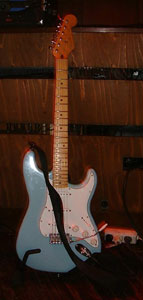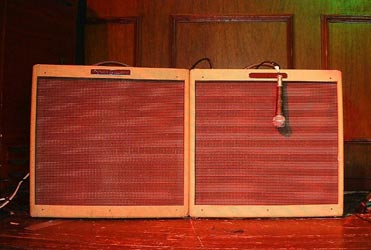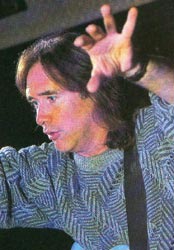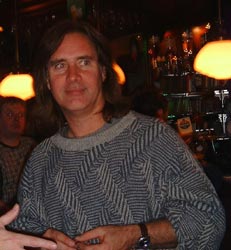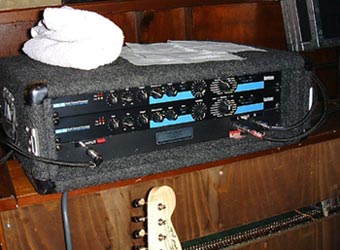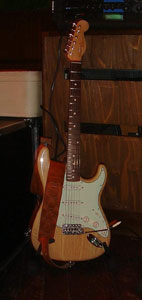Carl Verheyen was touring Europe for his new album ‘Atlas Overload’. It has been a long time since I saw him after the session we did in L.A. for the ‘Generator’ album in 1994. I caught up with Carl at the Bluescafé in Apeldoorn, where he was playing with Cliff Hugo and Steve Di Stanisloo. Check out the included intervallic lesson below.
Both the lesson and an edited version of this interview were printed in the Music Maker june 2001 issue over four pages.
:: A little bit about your history, please.
“Well, I grew up in Pasadena, started playing at age 11, got very serious from the very first day. I kept going, I played every single day my entire life (laughs) I played in a lot of Rock ‘n’ Roll bands in high school. Right after high school I picked up the acoustic guitar pretty heavily and started doing restaurants and gigs like that. Work on my voice. Then I got into jazz in my 20’s, pretty heavy. And I played a lot of jazz, went to Berklee college of music for one semester and when I came back to the L.A. area I played in a lot of jazz bands. It was right around 1980 that I started getting in all the studio work in L.A. I moved back into town and got serious about the studio scene.”
:: How did you get into the studio scene from the very start? Did you know some people around?
“A little bit. I knew a bass player and a drummer that were really good friends who were already starting to work. And also you found in L.A. that the studios…were where the hot players played. Guys like Larry Carlton, Robben Ford, Steve Lukather was just coming up. Those were the hot guys in town and they were all doing studio work. So it was definitely a thing to get into, and a good way to make a living, too. So I got into that ’till around ’85 when I joined supertramp. Then I skipped out for a couple of years, but then jumped back in, in ’87 and got right back into it again. With the exception of these tours that we do (with Carl’s own group-RH) a few more Supertramp tours and stuff, it’s all been the same kind of deal. Studio work while I’m home, touring with this band or with The Tramp.”
:: Must have been a big difference, touring-life wise, to start playing with Supertramp.
“Yeah, big difference (laughs) . That’s like, very first class. Best hotels, biggest arena’s, first class all the way. Whereas this band plays some small venues as you see in here! (Bluescafé Apeldoorn-small but cozy-RH) You get to see all the people’s faces, look right at ’em.”
:: How’s this tour been so far?
“Really good. We did a lot of Germany, a little Belgium, a couple of dates in Holland already, three. Then we will go to Danmark next week. This has been going great. We’ve been having at least 200 people a night, every single night. Just great. And sometimes 600, so we’re building it up, really getting a better crowd. Especially places we’ve already been.”
:: How many times have you been to Europe?
“This is our sixth trip. We’ve been coming here since ’97. We played Holland, too. Played in Paradiso one time. This year it’s Sittard and Den Bosch. We did a big workshop, too in Rotterdam for Line 6 at Feedback music. That was almost like a performance in a way, because there was such a big crowd.”
:: Why do you endorse Line 6 modeling amps and pedals while you, as a gear collector, probably have three or four of each original amp model that the Line 6 stuff is modeled after?
“Right. My deal with the amps is.. I own every amp they modelled. So I don’t really need the amps.I love the pedals. The pedals are a good way to use the modeling technology. I don’t think you can use modeling technology that effectively for amplifiers because you miss, like when you model a ’68 Plexi, you miss the 4 by 12″ bottom, you miss all those things that physically contribute to the sound. You can’t get that out of an amplifier with a 2 by 12″ open back, you know. And it really doesn’t have the depth of sound that the tube amps have. I love the pedals though. The modelling technology is pretty intelligent. Modeling a Leslie or something like that, that’s pretty good.”
:: Line 6 POD’s and pedals might come in handy in a studio situation too, when there’s no time or space or budget to record with your regular set up.
“I have their pedals and I have a POD. I don’t use their POD too much, it’s kind of a toy. But I do enjoy their pedals for just quick access to, for instance, delays. I love some of those low resolution delays that they have, that’s pretty smart. And I also think their distortion device is pretty good, it’s got some real over the top sounds. I have a lot of those original distortion pedals like the Fuzz-face and everything. To me, the Fuzz-face in the Line 6 pedals are actually a little cleaner sounding. So, it’s pretty good.”
:: Over the last years, hard-disk recording systems have been getting more and more affordable. With larger-quantity storage media, computer-based hard-disk recording is now in the hands of everybody. Everybody and his dog seems to have a home studio nowadays. How did that affect the L.A. studio scene?
“It has become a little different. I think the home studio will stay for lower budget projects. Things like TV and stuff, were the end-product is coming out of a little speaker and doesn’t matter as much as movies. Major films will always be done in studios as will most big records, with drums and everything. Even jingles,we track in studios all the time, not to many people’s houses. So, the studio scene is still alive and well. Budgets have fallen in the TV -world.. I used to do Cheers. That was a big session, every week. Now they’ll do it at somebody’s house and do three of ’em in a day. One particular television show I’ve got going right now is with a fifteen-piece orchestra every week. So..I’m missing it while I’m here!”
:: What happens with your session work when you’ve been out of town for a while?
“I still get the calls. I look at it like this: you can only get out and play your own music.. I think it’s a privilege, I think it’s something that you can only do a few times a year, you know, when the time is right, when you’re asked to. But there’ll always be studio work, there will always be that to fall back on, to go home to if I need it. But for the most part, I consider myself in the midst of a change, sort of a gradual leaning off of the day-to-day gigs, studio work, and getting more into the solo artist thing. Takes a long time though, because financially it’s so hard to do.”
:: Who takes your place when you’re out of town?
“Everybody I work for, all the composers, producers, arrangers and contractors, they’ve got me as their first call and a second, third and fourth after that. There’s different players subbing for every guy. For some guys it’s Dean Parks. Some guys it’s Michael Thompson for electric and so-and-so for acoustic. Everybody’s got a different guy they’re familiar with.”
:: You’ve did so many sessions. I would like to hear some of your session story’s. What’s your worst session and your most incredible session?
“Wow. I’ve had some session that have been really satisfying, like one time, I was asked to be the principle soloist with an about 85-piece orchestra. And play like, you know, Jeff Beck type stuff. That was really fun. They gave me take after take and said, ‘how did you like that one, you wanna try another one?’ And everytime I said ‘yeah, let’s do another one!’ 85 guys had to get back to their music. That’s pretty amazing. Some of the scarier ones.. one time I did a record date and the producer said like ‘well, I wanted to get Mike Landau, but he wasn’t available, so I’m stuck with you..’ And I said: ‘I just came from a session where I wiped all his tracks, ’cause they didn’t like his stuff!’ Which wasn’ true you know, Mike’s real good. But he started the session like that. Boy, was he just a rough, hardcore guy. No fun to work for. That was one of the worst, I couldn’t wait ’till I could leave. But generally, it doesn’t happen like that.”
:: I really dig that album you did with Chad Wackerman.
“Oh, you like that one?’The View’.”
:: Do you remember anything from that session?
“Yeah, that was really fun.Chad, being a drummer, he doesn’t know chord symbols. He doesn’t write C-minor, instead, he writes a stack of notes. But sometimes the stack is like: C, D, Eb and G. And you can’t play that. You can do this (strums chord with C, D, Eb and an open G-string) and that works. But I had to go through each stack to find the voicing. And I said like, ‘oh, that’s just a C minor 9, I’ll play it like this.’ But it was:’no, no, no, it’s gotta be like what the piano is doing.’ So it was very difficult to get the music together. And Chad is a very dear friend of mine, he did one of my tours. We played Paradiso together one time, I think it was ’98. When the ‘Slingshot’ record came out. His experience with the guitar has been Frank Zappa, Allan Holdsworth, a little bit of Andy Summers. You know, a little bit of a few other guys, and me. Off all those people, Allan is God. He loves Allan. And he wants you to sound exactly like Allan Holdsworth. And I just don’t. I don’t want to. So, it was fun, but it was difficult, because it was hard.. he doesn’t like the blues, he doesn’t like rock very much, he’s kind of.. avant-garde jazz is where he’s coming from.”
:: But I think that record turned out really good. There’s a nice contrast between Allan and your playing.
“Oh, good. We had a great time and Allan is a really dear friend of mine.”
:: You actually played together with Allan?
“I have a lot. But not on that record. We.. well yeah, we did one track together. Almost everything was recorded live at the Capitol Records studios. I played rhythm guitar on a track where he played a solo on. I’ve gone down to his house a couple of times too, we even wrote a song together. He’s a great guy.”
:: On your last album, Atlas Overload, almost everything is recorded live, too.
“Yeah, almost everything was live. A lot of the solos were straight on the basic tracks. The only overdubs were vocals for the most part and a few little parts here and there.
:: I saw you play a Flextone head and a POD during a Line 6 clinic. What settings do you use?
” I use the ‘Blackpanel’. That seems to work the best. I did a cruiseship gig where guitar magazines hired Steve Morse and me and Doyle Dykes to do some clinics and concerts on a guitar cruise. And all they had was a Flextone amp. All of us seemed to like the ‘Black panel’ the best. You know, I got about six Fender Amps and they all sound much different. But that ‘Blackpanel’ sound is a good place to start in a way.”
:: You don’t use any Line 6 amps or pedals live for your own tour.
“No, these Bassman’s sound great (points out two Fender Bassman’s onstage) They’re just reissue Bassman’s. They belong to my record company actually. My record company’s got Masrshalls, Fender’s, different things that they rent to me when I come over. I would like to use what my rig in the States is. Which is two 1964 Vox AC 30’s on top of two old 4 12″ bottoms. The Vox’s are the clean and the dirty is a ’68 Marshall Plexi, slaved through a ’69 100 W. It’s a great A/B system. Much bigger sounding. I use them for touring in the States, but I don’t really tour overseas with it, it’s too heavy to ship. One year, 1999, I got my German manager to give me all that stuff, the reissues. Due to the power conversion problem, I never got it working. I used the Vox’s for the most part. I just had ground hums and I couldn’t get rid of ’em. I used that same rig with Supertramp, but at that time I had a guitartech, who trouble shooted it in London for a month. We had rehearsals and every day he was working on it, and finally got it completely quiet. But it took a long time.”
:: A lot of people feel there’s a difference, tone wise, with the different voltage in the U.S. and Europe. 110 vs. 220, do you feel there’s any difference in your tone over here in Europe?
“I agree it sounds different. But it’s hard to tell where it sounds better. I got to admit, I spent a lot of time getting my sound in the U.S. so I’ve never heard vintage gear in Europe. Only new reissued stuff. So I gotta say my old ’68 and ’66 and ’69 Marshall sound better than the reissues I’ve heard here or there. So you know, it’s hard to tell.”
:: Tell me about your gear collection. You don’t keep your stuff at home but in a seperate place?
“Pretty much, yeah. I have about 18 guitars at home and about 25 in storage. I have about 64 altogether. They’re stored in these two huge trunks. Each one holds twelve. Twelve acoustics, that’s a monstrous truck. There’s mandoline’s, banjo’s all that stuff. It’s all stored at Andy Brauer’s place. Then there’s the electric trunk, which has twelve electrics. But I’ve been keeping my ’58 Strat, ’61 Strat, ’65 Strat all at home. If I think I got an important gig, I’ll bring one of those in. If I’m just doing a jingle or something, there’s other Strat’s I can use. Like this one (shows the Strat he’s fiddling on), this is a ’97 Tex-Mex. $300.-. And it sounds good. It’s a good little Strat, works pretty well.”
:: What pedals are you currently using? I saw a lot of boosting devices in your pedalboard.
“My favorite pedalboard distortion is called the ‘Green Rhino’. It’s made by George Tripps. He’s the guy that’s running the Line 6 pedals department now. He used to make pedals out of his garage and he was great. That’s like a nice, open, expanded sounding tube screamer. Then I’ve got a RAT pedal on there that was modified by Robert Stamps. It’s just really sweet. And then this old wah-wah pedal I think I bought when I was 18. Of all the wah-wah’s I got, my oldest one is on my pedal board for some reason. Then there’s a little Voodoo-labs Croq Pro Octavia, which sounds good, I like that pedal. Then there’s a pedal by Visual Sound called the ‘Route 66’. Which is not only a compressor, but a distortion thing, too. Actually, you won’t hear that tonight, because it’s on the ‘A’ side of my pedal board, which normally goes to my Vox’s and I’m only using the ‘B’ side of the rig on this tour. So that’s what I got on there, plus a tuner and a little power supply. Then in that little rack I brought over here (points out a small rack on stage) There’s two Lexicon’s MPX 100’s in there. I will leave ’em here. It’s my little ‘Euro-rack’. Together with a bunch of cables, a bunch of Dimarzio cords.”
:: Henderson does that too. He has a speaker cabinet in Japan and in Europe, so all he has to take is his rack and amp and plug it in.
“That’s a good idea. He’s a preamp-power amp guy.” (not completely.. Scott has been using a Custom Audio head for the last years-RH)
:: Do you think there’s a difference in tone between a preamp-power amp combination and a head?
“Yeah. I quit doing that in the 90’s..like 1990 is when I stopped with all that preamp stuff. I’m much more into heads.”
:: Can you remember the moment you decided to quit using rack stuff? What happened exactly?
“You know, it just became.. I had a big Bradshaw rig from about ’83 on. And right around ’90 I was playing my ’61 Strat, the ‘seafoam’green one. I couldn’t get as good of a sound out of, you know, $40.000.- worth of Bradshaw gear as I could out of my Princeton. And I realized it’s all about the marriage of the guitar to the amp. When you listen to a big FX rack, and I’ve still got one, not a Bradshaw but a Dave Friedman. You tend to listen to the chorus and the delays and the flanging and all the FX much more than the tone. So it came to my attention right away that the tone is what I really wanna hear. And I just got rid of all that stuff and started over. And I did have about 9 or 10 amplifiers at the time that I really wasn’t using, because I was using this Bradshaw stuff. So I went back to that and all of a sudden people were going:’man, you got a great sound, what are you using?’ I said ‘I’m not using all that shit, you know!.’ So I haven’t used any Bradshaw stuff since ’90. He’s still a friend of mine and I still like his stuff. It’s just that it’s not the sound I want. I just want a natural, real sound. I wanna be able to tell what pick up I’m on. I don’t want a square wave. My ’58 Strat has the best Strat pickups I’ve ever heard. Seymour Duncan told me:’hey there’s a Strat, you have to buy it, go get it’. He said they have the best pickups he’s ever heard. So I went down and bought it about 4, 5 years ago and man, putting that through one of those rigs is just silly, because those pick ups are so amazing.”
:: A lot of L.A. guitar players are using Bradshaw gear.
“Yeah. It has changed a bit. But yes, a lot of people are still using that Bradshaw rack stuff. It’s a convenience issue, you know. You realize you’re doing a session and the guy that’s hired you has just driven into town and been listening to Madonna on his CD player and goes ‘I want that sound!’. You gotta listen to it and be able to get that sound. You can’t get that sound with just anything, you gotta have to have everything. That’s what makes that a necessary thing.”
:: I heard you save all your musical ideas, phrases, etc. in a personal book?
“I’ve been keeping a musical diary since about 1979. Every day I practise I try to write down an idea or two. Just one or two bar things, sometimes longer. So I’ve got about 15, 20 volumes dating back to the 70’s. What’s nice is, that you can just check out where you were 10 years ago or 5 days ago or whatever.”
:: Who are you favorite guitar players, besides the obvious choices like Chet Atkins, Hendrix and Jeff Beck?
“Let’s see..let me think of somebody you don’t know that I listen to.. I’ve been listening to Robbie Macintosh a little bit lately. I bought his new record, it’s really nice. He’s the guy that played in the Pretenders for a while and he’s been playing in McCartney’s band for many years. He’s got a new album out, very good. And I like Sonny Landreth a whole lot. I play slide and I got a couple of slide guitars and dobro’s and stuff. I’m nowhere in his league, but I find him real inspiring. I think my music is simular in that it’s kind of rootsy, kinda coming from the heart, so I really relate to that. I like to listen to SRV, David Gilmoure, Clapton, all those guys too. Wes Montgomery, John Scofield, I bought one of his CD’s to take on the road with me. Probably a whole lot of other ones too. I’m coming out with an acoustic CD. It’ll be released in april. It’s got 15 tracks, all of em acoustic..actually, there’s 2 electrics on there. And they’re all solo pieces, except for the last one.”
:: Recorded at your home studio?
“No, I don’t have a home studio really. I’ve just got a little Korg D8 recorder, but it’s not really broadcast quality. So I recorded at a real studio, but it was really a fun thing to do, because I didn’t have a deadline. So I could literally practise for two weeks on one tune and go down there and record it. That was really a blast.”
:: Will it be released on the same label as your last album?
” I’m not sure yet. It was a record I did to get out of my U.S. record deal. So it’s released in the States and it might be picked up here. I have a feeling it will. It’s a whole other side of me, it’s got jazz, some country stuff, a lot of those kinds of things.”
:: Any plans for the future?
“When we get back we’re gonna try to tour a little bit in the States, trip down to Texas and the south-west, trying to get to the east coast this year. And I’m gonna do a live album with this band next. I wish I was recording this tour, this tour is rockin’. My goal is to make all my musical experiences first class, wether it’s my band or it’s some jazz guys at home, or playing with Supertramp. I just want it all to be at the highest level of musical�not necessary ability ..what’s the word.. musical ideals, you know. Just as good as it can be. I don’t wanna play with idiots or boneheads.
:: You brought a pretty good band, indeed.
“Well, these guys are amazing. Cliff (Hugo-bass player, Ray Charles, Supertramp, a.o.) is unbelievable. Steve’s (Di Stanisloo-drums, Dave Crosby, Joe Walsh) really good, too. It’s just what the band needs, just rock-solid. The tour we did with Chad (Wackerman), he’s got all these incredible chops and everything. But in many ways, Steve’s the best drummer for this band because he just lays into it.”
:: Concluding, I heard you say during a Line 6 clinic that you were a little worried about the next generation of musicians. You said there’s not that many real ‘players’ around, in the traditional sense of the word, and people have no clue how to jam anymore.
“Well, I have met some really good, young players.What I don’t find is that desire to learn everything. To get some Chet Atkins, some Jeff Beck, some Wes Montgomery, some Ozzy, you know, all this spectrum of music, I don’t find that so much. And I haven’t found a lot of guys that really love to jam. When we were all coming up, that’s what we did, we got together after school and jammed and I still do. And that’s what I’m gonna do tonight. We have incredible sections in the show were we stretch and it’s because we can. You don’t hear that too much, you don’t hear guys spontaneously in it. That’s a little worry some. I had a long talk with Abe Laboriel about that. And he said:’I don’t think we’re building a better musical generation.’ But he has nothing to worry about, his son pays great! (Abe Laboriel Jr) My son’s only five, so I got a little time. He not into music already, but he says ‘oh yeah, dad, I’m gonna play guitar, drums and piano..but not now..he’s busy.” (Laughter)
Despite his busy schedule, Carl was kind enough to take some time to share some of his intervallic ideas. If you’re familiar with his work, you might have noticed the great intervallic ideas he plays. Carl also uses the fingers of his right hand, so watch for the indications between the notes and tablature. When asked to demonstrate some of his intervallic figures, Carl played this first example at lightning speed. The line works over a minor-7 chord and uses notes from the D-Dorian mode. Watch for those right hand indications: an arrow stands for pick attack, ‘m’ is for middle finger and ‘i’ stands for index finger. Also be aware of those slides and hammer-ons and pull-offs.
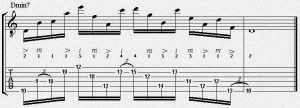
To demonstrate the same concept over a different chord Carl played this example that would work over a D7. The advantages of the ‘hybrid’ picking technique are very clear here: Carl jumps from the ‘E’ to ‘D’ to ‘B’string, with a minimum amount of right hand movement.
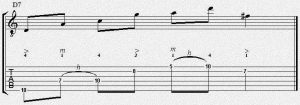
Here Carl shows something he would play over a maj7 chord. Although the written music only shows one bar, Carl actually played this line all the way up to the 17th fret. Try to keep the slides in tempo here.

Asked for an ‘alternative’ scale, Carl played this A melodic Minor line over a D7 chord. The D7 chord exists of the notes D-F#-A-C. A melodic minor are the notes: A-B-C-D-E-F#-G#. Playing this scale over a D7 chord gives the jazzy . D7#11 flavour.
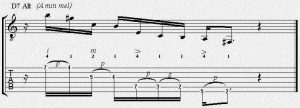
Try to personalize these lines by playing them with your favorite rhythms and trying them with different scales and over different chord progressions. Good luck!
